| History
of German SEEHUND Midget Submarine |
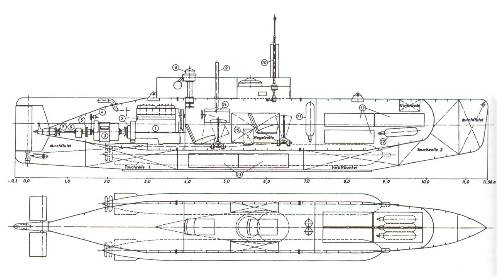
Draft concept sketch, Typ XXVII B5
(127)
collaboration between MBR Grim (OKM-KIUe) and consultant engineer "Glückauft"
in Blankenburg/Harz
Photo courtesy from Die Seehunde - Klein U Boote
|
|
Genesis
of the design
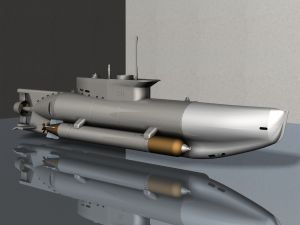 On the whole, German midget submarine designs owed more to desperation
rather than good naval design practice. There was, however, one German good
design which was a cut above the rest of which, had it not been for the vast
array of countermeasures deployed against them, might have made some impact
on the course of the war. This craft was the Seehund or type 127 submarine.
This was a two man craft armed with two torpedoes and capable of extended
operations.
On the whole, German midget submarine designs owed more to desperation
rather than good naval design practice. There was, however, one German good
design which was a cut above the rest of which, had it not been for the vast
array of countermeasures deployed against them, might have made some impact
on the course of the war. This craft was the Seehund or type 127 submarine.
This was a two man craft armed with two torpedoes and capable of extended
operations.
The original of the Seehund lay in the recovery of the remains of X6
and X7 from the depths of Kaafjord. Subsequently the Hauptamt Kriegschiffbau
produced a design for a two-man midget submarine designated Type XXVIIA,
also know as Hecht (Pike). Like the X-Craft, Hecht was designed to carry
mines to be laid beneath the hulls of enemy ships, but it was substantially
smaller and differed from its British counterpart in a number of significant
ways. To begin with, Hecht’s designers saw no need for a dual diesel /
electric motor propulsion system. It was envisaged that Hecht would operate
submerged all the time and therefore was no need for a diesel engine. The
power plant consisted of an 8 MAL 210
Battery
based on five 17T torpedoes troughs driving a 12 hp AEG torpedoes engine.
Even so Hecht’s endurance was a paltry 69mm at 4 Kts. Since the craft
would have to pass through nets and other obstructions she was not
originally fitted with hydroplanes or stabilizing fins. Instead adjustable
weights on spindles were fitted inside the boat. This method proved
completely ineffective since the weight could not be moved quickly enough in
an emergency to affect the trim of the boat and hydroplanes and stabilizing
fins had to be fitted subsequently. Even so, submerged control was very
poor. Since Hecht would be operating dived, she was not fitted was ballast
tanks, and two compensating tanks gave the craft sufficient buoyancy to lie
awash on the surface.
|
|
Although Hecht was designed to carry an explosive charge, Donitz insisted
that a torpedo be fitted so that attacks could be mounted on shipping in
coastal waters.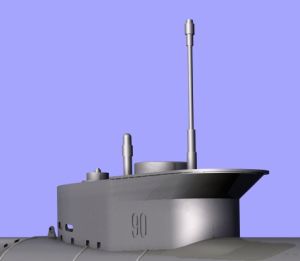 Hecht’s lack of buoyancy meant that only torpedoes without
negative buoyancy could be used and these were of relatively short range.
Accordingly Hecht was fitted for both torpedo carrying and mine. If a
torpedo was carried then a further three battery troughs could be fitted.
Externally Hecht resembled a British Welman. In the nose of the craft was
the detachable mine. In the forward section were the battery and a
gyrocompass. Hecht was the first German midget submarine to be fitted with
gyrocompass, which was deemed essential for navigation if the craft were to
be spending so much time submerged. Behind the battery was the control
compartment with seats for the two-man crew, another new departure for the
Germans. Hecht’s lack of buoyancy meant that only torpedoes without
negative buoyancy could be used and these were of relatively short range.
Accordingly Hecht was fitted for both torpedo carrying and mine. If a
torpedo was carried then a further three battery troughs could be fitted.
Externally Hecht resembled a British Welman. In the nose of the craft was
the detachable mine. In the forward section were the battery and a
gyrocompass. Hecht was the first German midget submarine to be fitted with
gyrocompass, which was deemed essential for navigation if the craft were to
be spending so much time submerged. Behind the battery was the control
compartment with seats for the two-man crew, another new departure for the
Germans.
The two men could offer each other mutual support and share the watch
keeping/routine maintenance load. The crew sat in seat arranged fore and aft
on the centerline with the engineer sitting forward and the commander aft.
The latter was provided with a simple periscope and a Plexiglas dome for
navigation purposes. Further aft was the electric motor.
|
|
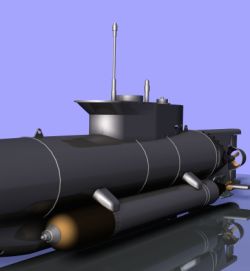 On
18 January 1944
Donitz discussed the new design
with Hitler who expressed his approval for these new craft. On 9 March
contracts were placed with Germaniawerft for the construction of a
prototype, followed by another for fifty-two boats on 28 March. The
fifty-three boat were built between May and August 1944: none saw active
service but all were employed in the training role for Seehund crews. At the
same time as the orders were being placed, numerous variations on the Hecht
were under construction. The first was the Type XXVIIB that had increased
range, an armament of two torpedoes and dual diesel/electric propulsion. The
initial design was complete by the end of June 1944 and showed a craft which
strongly resembled Hecht in many ways but which was fitted with a
ship-shaped casing for better sea keeping while on the surface, and saddle
tanks. More room had been created inside the craft by placing the battery
troughs in the keel while the two torpedoes were slung externally in
recesses in the hull. A 22 hp diesel as fitted for surface travel and it was
estimated that this would provide a surface speed of 5.5 kts, while a 25 hp
electric motor gave a submerged speed of 6.9 kts. On
18 January 1944
Donitz discussed the new design
with Hitler who expressed his approval for these new craft. On 9 March
contracts were placed with Germaniawerft for the construction of a
prototype, followed by another for fifty-two boats on 28 March. The
fifty-three boat were built between May and August 1944: none saw active
service but all were employed in the training role for Seehund crews. At the
same time as the orders were being placed, numerous variations on the Hecht
were under construction. The first was the Type XXVIIB that had increased
range, an armament of two torpedoes and dual diesel/electric propulsion. The
initial design was complete by the end of June 1944 and showed a craft which
strongly resembled Hecht in many ways but which was fitted with a
ship-shaped casing for better sea keeping while on the surface, and saddle
tanks. More room had been created inside the craft by placing the battery
troughs in the keel while the two torpedoes were slung externally in
recesses in the hull. A 22 hp diesel as fitted for surface travel and it was
estimated that this would provide a surface speed of 5.5 kts, while a 25 hp
electric motor gave a submerged speed of 6.9 kts.
|
|
A variants of the Type XXVIIB was the Klein U-boot K which differed only in
that it was powered by a close cycle engine. The proposal came from Chief
Naval Construction Adviser Kurzak who was the Kriegmarine’s representative
for closed-cycle propulsion at Germaniawerft. The boat was powered by a 95
hp diesel engine commonly use in the Kriegmarine’s small boats and which
therefore available in quantity. The engine ran off oxygen, 1250 liters of
which were stored in the boat’s keel at four times atmosphere pressure. It
was anticipated that the boat would has a maximum submerged speed of 11-12
kts and a range of 70 miles at that speed. For long range travel, the boat
would have a range of 150 miles at 7 kts. Kurzak presented his design at a
meeting chaired by Vice-admiral Heye on
21 May 1944
and was requested to develop a
close-cycle engine appropriate for such a submarine.

|
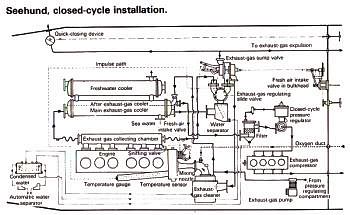

|
|
|
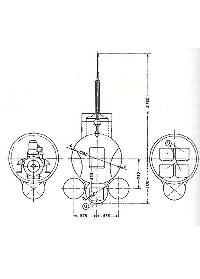 Construction
and design Construction
and design
Kurzak’s
proposal had a considerable influence on the final variants of the Type
XXVII. This finally emerged as the Type XXVIIB5, better known as the
Seehund (Seal) or Type 127. Seehund had a boat-shaped hull with a small
raised platform amidships containing the air intake mast, the magnetic
compass, the 10m periscope and a glass dome was built to withstand
pressure down a depth of 45m. The casing contained the ballast tanks and a
free-flooding compartment forward. Inside the pressure hull, the layout
resembled that of the Hecht. In the forward part were four of the seven
Mal 210 battery troughs, the other stowed in the keel. In the center of
the craft was the control compartment with seats for two operators. The
engineer handled the controls and fired the torpedoes on the word of the
commander. During the attack the boat was kept at periscope depth and
‘talked’ onto the target by the commander. The fixed 10m periscope was
of excellent design and incorporated lenses which allowed the commander to
search the skies before surfacing – vital in view of overwhelming air
superiority now possessed by the Allies. The armament of the Seehund was
the standard two G7e torpedoes slung in recesses under the hull, which
meant that the boat had to be removed from the water before loading
weapons, a tiresome procedure at the best of times.
|
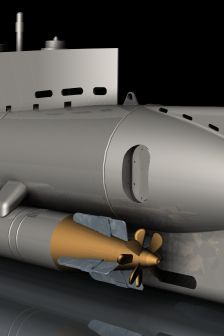
|
|
In the after part of the boat was the diesel and electric motor. Seehund
were powered by a 60 hp Bussing diesel with a 25 hp AEG electric motor for
submerged drive. This gave an endurance of 270nm on the surface at 7 Kts.
If exterior fuel tanks were used, the range went up to as much as 500nm
– although the crew’s efficiency throughout such a long passage would
have been doubtful. Submerged endurance was 63nm at 3 Kts. These figures
were rather disappointing and it was apparent that the hull form,
particularly when torpedoes were carried, exerted considerable resistance.
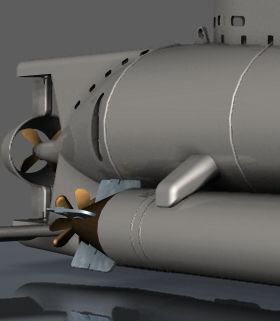 The
first contract for Seehund construction was placed on
30 July 1944
. Enthusiasm for this craft was
so great that most of the contracts and hull numbers had been allocated
before the design was complete. The Ministerial Programmed of June 1944
envisaged a total of 1000 Type XXVII boats in service. Germaniawerft and Chichi
at Elbing were to build twenty-five and forty-five boats per
month respectively. Other centers involved in Seehund production were CRD
at Monfalcone on the
Adriatic
and Klockner-Humbolt-Deutz at
Ulm
. Like so many other schemes in
the Third Reich, reality fell far short of expectations. Donitz would not
consent to the production of the Type XXVII U-boat being held up for
Seehund construction, while raw material shortages, labor difficulties,
transport problems and conflicting priorities in Germany’s crumbling war
economy all combined to reduce Seehund production. In the event Seehund
production was concentrated at the Konrad bunker under Germaniawerft in
Kiel
which was not longer required
for Type XXI or Type XXIII production. A total of 285 units were built and
allocated irregular numbers in the range U-5501 to U-6442. The
first contract for Seehund construction was placed on
30 July 1944
. Enthusiasm for this craft was
so great that most of the contracts and hull numbers had been allocated
before the design was complete. The Ministerial Programmed of June 1944
envisaged a total of 1000 Type XXVII boats in service. Germaniawerft and Chichi
at Elbing were to build twenty-five and forty-five boats per
month respectively. Other centers involved in Seehund production were CRD
at Monfalcone on the
Adriatic
and Klockner-Humbolt-Deutz at
Ulm
. Like so many other schemes in
the Third Reich, reality fell far short of expectations. Donitz would not
consent to the production of the Type XXVII U-boat being held up for
Seehund construction, while raw material shortages, labor difficulties,
transport problems and conflicting priorities in Germany’s crumbling war
economy all combined to reduce Seehund production. In the event Seehund
production was concentrated at the Konrad bunker under Germaniawerft in
Kiel
which was not longer required
for Type XXI or Type XXIII production. A total of 285 units were built and
allocated irregular numbers in the range U-5501 to U-6442.
|
|
The
production schedule for Seehund was as follows : September 1944, 3 units;
October 1944, 35 units; November 1944, 61 units; December 1944, 70 units;
January 1945, 46 units; February 1945, 27 units; March 1945, 46 units and
April 1945, 8 units. While the design process was well in hand Chief Naval
Construction Adviser Kurzak proposed the incorporation of a close-cycle
power-plant into the design to achieve significant savings in volume and
weight. The design was similar to the Klein U-boot K described earlier but
of slightly larger dimensions. The engine installation, the Daimler Benz
OM67/4 of 100 hp (with an electric motor for silent creep speed) was
selected, and was to be mounted on a common frame which could be simply
inserted into the stern section for easy access and secured by a few
screws. Significantly, attention was paid to reducing engine noise as much
as possible. The common frame was mounted on an elastic bedding using four
rubber buffers at the edges of the frame. It was hoped that noise
reduction measures would be effective that the silent creep speed electric
motor could be dispensed with altogether thus making the power plant
extremely simple and light. The closed cycle Seehund would have a
submerged range of 69 nm at 11. Kts or 150 nm at 7.25 kts.
|
|
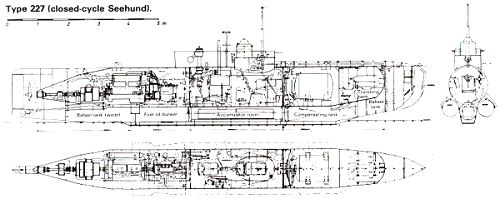
Close Cycle Seehund Type 227
Photo Courtesy from The U-Boat
|
Development of the closed cycle Seehund was carried out by Ingenioeurburo
Gluckauf in Blankenburg and was given the designation Type 227. Contracts
for prototypes were awarded to Germaniawerft in
Kiel
and to Schichau at Elbing and by May 1945 a contract for three operational
model (U-5188 to U-5190) had been awarded to Germeniawerft. These models
would have used the standard Seehund power plant converted to closed cycle
operation on the grounds the Daimler-Benz engines were not available in
any quantity. Tests showed that the Bussing engine could be successfully
converted by the world ended before the craft could go into production.
Table below is a rough comparison between the original Type XXVII, the
Seehund and the Type 227.
Delivery Schedule of Seehund
The Ministerial Program of June 1944 planned a total of 1,000 Type XXVII
midget U-boats, of which Elbing was to supply 45 and GW 25 boats per
month. Initially, it was intended to manage without other production
centers. When GW took over the complete Type XXIII construction, it would
then cease to take part in the Seehund program, and production of these
would then begin in southern Germany. At the beginning of January 1945,
the delivery plan for Seehund was as shown in (table A)
When Schichau, Elbing, was no longer available, it was decided, on 30
January 1945, to accelerate the commencement of construction of Seehund at
Klöckner-Humboldt-Deutz in Ulm, and at the firm of W.Schenk in Hall,
using Elbing personnel, and to rise production to 50 boats per month by
July 1945 as shown in (Table B)
At the same time, GW was to continue to deliver. The total program was
reduced to 600 boats in the emergency program. As the Konrad shelter in
Kiel was now required neither for Type XXI nor for XXIII, it could be used
additionally by GW for Seehund construction.
Sequence production was carried on there from the middle of March, while
production at Ulm, which was not very accessible from a transport point of
view, was stopped and construction at Hall did not begin. The main
difficulty that developed in the latter stages of the war, and was to
affect even the Seehund program, was the bottleneck in accumulators. Thus
in March 1945, instead of 60 Seehund batteries, only 40 could be provided.
The total of Seehund delivered is shown in (Table C).
3 Seehund was produced at Howaldt-Kiel, 135 at Schichau, Elbing, and the
remainder at GW.
|
Delivery
program for Seehund, January 1945 (Table A) |
| 1945 |
Schichau,
Elbing |
GW,
Howaldt Kiel |
Southern
Germany |
| January |
55 |
25 |
- |
| February |
55 |
25 |
3 |
| March |
55 |
30 |
5 |
| April |
55 |
30 |
10 |
| May |
55 |
25 |
20 |
| June |
55 |
- |
30 |
| July |
55 |
- |
35 |
| Source
from The U-boat - ISBN 0-304-36120-8 |
|
Revised Seehund
construction program, 30 January 1945 - excluding GW(Table B) |
| 1945 |
Ulm |
Hall |
| January |
- |
- |
| February |
5 |
- |
| March |
10 |
- |
| April |
10 |
5 |
| May |
10 |
15 |
| June |
10 |
25 |
| July |
10 |
40 |
| Source
from The U-boat - ISBN 0-304-36120-8 |
|
Actual
Delivery for Seehund (Table C) |
| Year/Month |
Seehund |
| 1944 |
- |
| May |
- |
| June |
- |
| July |
- |
| August |
- |
| September |
3 |
| October |
35 |
| November |
61 |
| December |
70 |
|
1945 |
|
| January |
35 |
| February |
27 |
| March |
46 |
| April |
8 |
| Source
from The U-boat - ISBN 0-304-36120-8 |
|
German Submarine
Builder :
 Blohm+Voss : Blohm & Voss, Hamburg
Blohm+Voss : Blohm & Voss, Hamburg
 Bremer Vulkan : AG
Bremer Vulkan, Vegesack Bremer Vulkan : AG
Bremer Vulkan, Vegesack
 Danzig : Danziger
Werft, Danzig Danzig : Danziger
Werft, Danzig
 Deschimag :
Deschimag AG, Weser, Bremen Deschimag :
Deschimag AG, Weser, Bremen
 Deutsche Werft
(with yard at Finkenwerder, Gotenhafen, Kiel, Reiherstieg ) Deutsche Werft
(with yard at Finkenwerder, Gotenhafen, Kiel, Reiherstieg )
 Flender : Lubecker
Flender Werke, Lubeck Flender : Lubecker
Flender Werke, Lubeck
 Flensburg :
Flensburger Schiffbau Gesellschaft, Flensburg Flensburg :
Flensburger Schiffbau Gesellschaft, Flensburg
 Germania :
Friedrich Krupp AG, Germaniawerft Germania :
Friedrich Krupp AG, Germaniawerft
 Howaldt :
Howaldtwerke, Hamburg Howaldt :
Howaldtwerke, Hamburg
 KMW :
Kriegsmarine-Werft, Wilhelmshaven KMW :
Kriegsmarine-Werft, Wilhelmshaven
 Nordsee :
Nordseewerke Emden AG, Emden Nordsee :
Nordseewerke Emden AG, Emden
 Oderwerke :
Stettiner Oderwerke, Stettin Oderwerke :
Stettiner Oderwerke, Stettin
 Neptun : AG Neptun,
Rostock Neptun : AG Neptun,
Rostock
 Schichau : F
Schichau GmbH Werk, Danzig and Elbing Schichau : F
Schichau GmbH Werk, Danzig and Elbing
 Seebeck :
Deschimag Werk, Wesermunde Seebeck :
Deschimag Werk, Wesermunde
 Stulcken : HC
Stulcken Sohn, Hamburg Stulcken : HC
Stulcken Sohn, Hamburg
|
|

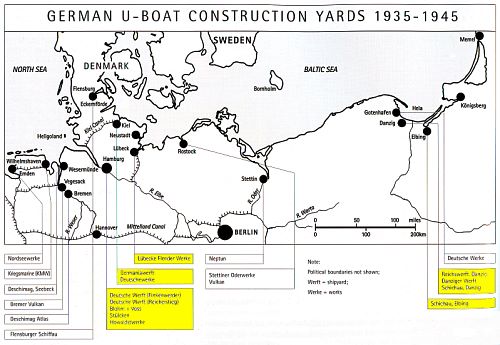
German U-Boat Construction Yards
Photo courtesy from :
U-Boats - The Illustrated history of the raiders of the deep
|
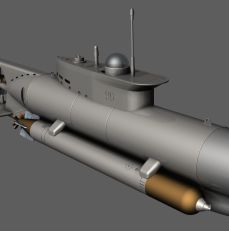 The Seehund was the most sophisticated of all the midgets which went into
production for the Kriegsmarine. From the Allied perspective its small
size made it almost impossible for Asdic to get a return of her tiny hull
while her very quiet slow speed made her almost impervious to hydrophone
detection. As the Commander-in-Chief Portsmouth, Admiral Sir Charles
Little, succinctly put it, ‘fortunately for us these damn things arrived
too late in the war to do any damage”.
The Seehund was the most sophisticated of all the midgets which went into
production for the Kriegsmarine. From the Allied perspective its small
size made it almost impossible for Asdic to get a return of her tiny hull
while her very quiet slow speed made her almost impervious to hydrophone
detection. As the Commander-in-Chief Portsmouth, Admiral Sir Charles
Little, succinctly put it, ‘fortunately for us these damn things arrived
too late in the war to do any damage”.
References :
A extract from the Book : Midget Submarine of the Second World War by Paul
Kemp
ISBN : 1-86176-042-6 - Chatham Publishing
A extract from the book : The
U-boat, The evolution and technical history of German Submarines
ISBN : 0-304-36120-8 - Cassell&Co
|
|
|
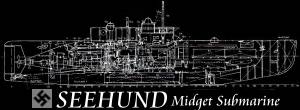

 The Seehund was the most sophisticated of all the midgets which went into
production for the Kriegsmarine. From the Allied perspective its small
size made it almost impossible for Asdic to get a return of her tiny hull
while her very quiet slow speed made her almost impervious to hydrophone
detection. As the Commander-in-Chief Portsmouth, Admiral Sir Charles
Little, succinctly put it, ‘fortunately for us these damn things arrived
too late in the war to do any damage”.
The Seehund was the most sophisticated of all the midgets which went into
production for the Kriegsmarine. From the Allied perspective its small
size made it almost impossible for Asdic to get a return of her tiny hull
while her very quiet slow speed made her almost impervious to hydrophone
detection. As the Commander-in-Chief Portsmouth, Admiral Sir Charles
Little, succinctly put it, ‘fortunately for us these damn things arrived
too late in the war to do any damage”.